
Illustration of tree, cones, and foliage [Matt Strieby, 2020].
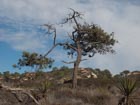
A fairly typical tree in habitat, Torrey Pines State Reserve, CA [C.J. Earle, 2013.01.01].
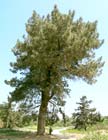
A tree at Rancho Santa Ana Botanical Garden, CA [C.J. Earle, 1998.04.13].
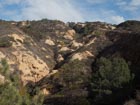
A stand of trees in typical habitat, Torrey Pines State Reserve, CA [C.J. Earle, 2013.01.01].
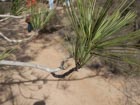
Twigs and foliage on a tree in habitat, Torrey Pines State Reserve, CA [C.J. Earle, 2013.01.01].
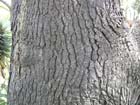
Bark on a large tree at Quail Botanical Gardens, CA [C.J. Earle, 2004.04.06].
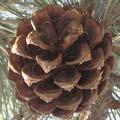
Open cone on a tree at Quail Botanical Gardens, CA [C.J. Earle, 2004.04.06].
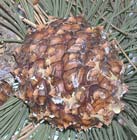
Closed cone on a tree at Quail Botanical Gardens, CA [C.J. Earle, 2004.04.06].
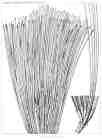
Foliage, from the original description (Torrey 1858).
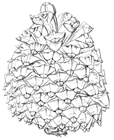
Cone, from the original description (Torrey 1858).

The Wardholme Pine in Carpenteria, CA; planted 1888, now the largest known specimen. Var. insularis [C.J. Earle, 2020.12.21].


(oddly, both subspecies are Endangered)
Pinus torreyana
Parry ex Carrière 1855
Common names
Torrey, Soledad, lone or Del Mar pine (Peattie 1950).
Taxonomic notes
Two varieties (or, in some sources, subspecies), torreyana and insularis (Kral 1993).
The distribution is disjunct, with a population on the mainland (where the type was collected) and a slightly smaller population on Santa Rosa Island. Haller (1986) found differences in cone and seed shape and crown form, then describing the island population as a new subspecies, P. torreyana subsp. insularis Haller (syn. P. torreyana var. insularis (Haller) Silba (1990)).
An earlier report on resin composition (Zavarin et al. 1967), and two genetic studies (Ledig and Conkle 1983, Waters and Schaal 1991) show the differences between the mainland and island populations are minimal: "No variation is detected in the chloroplast genome of Pinus torreyana" (Waters and Schaal 1991). Isolation of the two populations may have only occurred in the last 8000 years (Waters and Schaal 1991), a short time in conifer evolution terms. Even the separation time of 180,000 years suggested by Ledig & Conkle (1983) is brief in comparison with the 30 million years separation between 'North Plateau' and 'Pacific' Ponderosa pines (here accepted as Pinus ponderosa subsp. ponderosa and its subsp. benthamiana), calculated using the same methodology by Critchfield (1984). For this low level of differentiation, the rank of subspecies is not appropriate, with Silba's varietal combination being more suitable.
Description
Tree to 15(-23) m tall with a dbh of up to 100 cm, in nature mostly crooked and leaning, but tall and straight in planted stands and ornamentals; crown rounded to flattened or irregular. Bark red-brown to purple-red, deeply furrowed with irregular, elongate, flat, scaly ridges. Branches irregular, spreading-ascending, resembling a candelabra; twigs stout (1-2 cm thick), green, aging deep gray-brown, rough. Leaves mostly 5 per fascicle, ascending or spreading, persisting 3-4 years, (15-)20-30(-33) cm × 2 mm, straight or curved, slightly twisted, dark green, all surfaces with fine stomatal lines, margins serrulate, apex abruptly acute; sheath to 2 cm, shed early, base persistent. Buds conic-ovoid, pale brown, to 2.5 cm; scale margins white-fringed. Leaves clustered near branch tips, giving a tufted appearance. Cones lateral, massive, heavy, symmetric, ovoid before opening, broadly ovoid when open, 10-15 cm long, yellow- to red-brown, lustrous, on peducles up to 4 cm long; maturing in 3 years, shedding seeds soon thereafter, persisting to 5 years. Cone scales with thick apophyses, angulately dome-shaped, with 5 low convergent keels; umbo central, forming a short, curved-tipped pyramid. Pollen cones ovoid, 20-30 mm, yellow. Seeds narrowly obovoid; body 16-24 mm, brown, apically dark brown; wing broad, oblique-tipped, to 15 mm long. Wood soft, coarse-grained (Elias 1987, Kral 1993).
Distribution and Ecology
USA: California: the coast at Del Mar in San Diego County, and the E end of Santa Rosa Island (Peattie 1950). Hardy to Zone 8 (cold hardiness limit between -12.1°C and -6.7°C) (Bannister and Neuner 2001). See also Thompson et al. (1999).
Distribution data from USGS (1999).
Remarkable Specimens
The largest known specimen belongs to var. insularis. Ages are little-documented. Most sources describe, without data, ages of about 150 years. Nichol [no date] refers to a tree "about 200 years old" as determined by increment borer, presumably by a simple ring count.
Ethnobotany
"A family of the Kumenay Indians of California who owned a grove of P. torreyana managed it by burning it regularly and planting seeds to expand it (Shipek 1989)" (Richardson 1998 [Chapter 1, table 1.2]) - possibly the earliest record of deliberate planting of any conifer in the New World. USDA hardiness zone 9.
Observations
See the variety descriptions.
Remarks
The species was discovered and described by Parry during the course of the Mexican-American Boundary Survey, and shortly thereafter was described by Torrey (1858) in the report of that expedition. I repeat that description here as an item of historical interest; the illustrations are shown at right:
PINUS TORREYANA (Parry MSS): foliis quinis elongatis (6-9-unc) rigidis, vaginis squamosis (5-10-lin.) strobilis subglobosis, squamarum apophysi elongato-pyramidata deflexa, umbone continuo obtuso subrecurvo. (TAB. LVIII and LIX.) Bluffs near the mouth of Solidad creek, 10 miles north of San Diego, California; Parry. A small tree, seldom more than 20 or 30 feet high, with a trunk 12 to 15 inches in diameter; often almost prostrate from its being exposed to strong ocean gales. Bark of the young branches whitish; the lower part of the trunk scaly. Branches horizontal, but curved upward towards the extremity. Leaves stouter than in any other North American pine, rough on the margin, abruptly pointed, the sheaths nearly two lines in diameter and an inch and a half long in the young leaves. Cones conical-globose, about 4 1/2 inches long. Seeds, without the wing, three-fourths of an inch long, with a thick bony shell. This is the only pine of the section Pseudo-strobus found within the limits of our flora. P. Apulcensis which resembles it, differs in its more slender and shorter leaves, and ovate smaller cones, &c. It is also allied to P. Orizabae, Gordon in Lond. Hort. Jour. 1, p. 237 cum icon., but that has very slender leaves, which are extremely rough on the angle, and ovate cones.
Although P. torreyana is now a local endemic, "its distribution in Oligocene and Miocene (or at least that of its near ancestor) extended north to Oregon. Its harsh natural habitat elicits an unusually contorted and often sparse form, quite unlike the cleaner and taller form the species takes in cultivation.
"In terms of numbers of individuals in the wild, as well as the small area occupied by natural populations, Pinus torreyana is without a doubt the rarest North American pine. As such it is under protection. Artificial crosses between it and another, more widespread Tertiary relic, P. sabiniana, have been successful" (Kral 1993).
The species is being evaluated as a potentially valuable timber tree in Australia and New Zealand, where it can grow faster than P. radiata on poor sites, notably on heavy clay and shale. Growth to 20 m in 20 years is recorded in New Zealand. Seed procurement is the major barrier to increased usage. (Spencer 1991).
Citations
Carrière, E. A. 1855. Traité général des conifères ou déscription de toutes les espèces et variétés aujourd'hui connues, avec leur synonymie, l'indication des procédés de culture et de multiplication qu'il convient de leur appliquer. Chez L'Auteur, Paris (p. 326).
Haller, J.R. 1986. Taxonomy and relationships of the mainland and island populations of Pinus torreyana. Systematic Botany 11: 39-50.
Ledig, F.T. and M.T. Conkle 1983. Gene diversity and genetic structure in a narrow endemic, Torrey pine. Evolution 37: 79-85.
Nicol, Hank. [no date]. Parry Grove. www.torreypine.org/parks/parry-grove.html, accessed 2013.01.06, now defunct..
Silba, J. 1990. A supplement to the international census of the coniferae 2. Phytologia 68: 7-78.
Spencer, D. 1991. Torrey pine: an example of how the appearance of a species in its natural habitat can be deceptive. Newsletter Conif. Soc. Austral. 9: 10.
Torrey, J. 1858. Botany of the boundary. In W.H. Emory, Report on the United States and Mexican Boundary Survey, Vol. 2, Part 2. Washington, D.C.: A.O.P. Nicholson. Available at www.archive.org, accessed 2009.02.13.
Waters, E.R. and B.A. Schaal 1991. No variation is detected in the chloroplast genome of Pinus torreyana. Canadian Journal of Forest Research 21: 1832-1835.
Zavarin, E., W. Hathaway, T. Reichert & Y.B. Linhart. 1967. Chemotaxonomic study of Pinus torreyana turpentine. Phytochemistry 6: 1019-1023.
This page co-edited with M.P. Frankis, 1999.03.
See also
Elwes and Henry 1906-1913 at the Biodiversity Heritage Library. This series of volumes, privately printed, provides some of the most engaging descriptions of conifers ever published. Although they only treat species cultivated in the U.K. and Ireland, and the taxonomy is a bit dated, still these accounts are thorough, treating such topics as species description, range, varieties, exceptionally old or tall specimens, remarkable trees, and cultivation. Despite being over a century old, they are generally accurate, and are illustrated with some remarkable photographs and lithographs.
FEIS database.
The species account at Threatened Conifers of the World.
Nicol, Hank. [no date]. The Torrey Pine. http://www.torreypine.org/parks/torrey-pine.html, accessed 2013.01.06, now defunct.
Nicol, Hank. 1981. Notes from the Naturalist. San Diego: Torrey Pines Docent Society. Available for download from Google Books, accessed 2013.01.06.
Sargent (1897) provides an exceptionally detailed description of this species, with an excellent illustration.
Veirs, Stephen D., Jr. 1995. Torrey Pine. In Status and Trends of the Nation's Biological Resources. USGS electronic publication. http://biology.usgs.gov/s+t/SNT/noframe/ca164.htm, accessed 2001.02.21.











